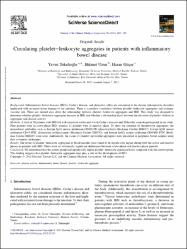| dc.contributor.author | Tekelioğlu, Yavuz | |
| dc.contributor.author | Uzun, Hikmet | |
| dc.contributor.author | Güçer, Hasan | |
| dc.date.accessioned | 2020-12-19T20:16:04Z | |
| dc.date.available | 2020-12-19T20:16:04Z | |
| dc.date.issued | 2013 | |
| dc.identifier.citation | Tekelioglu, Y., Uzun, H., Gucer, H., (2013).Circulating platelet-leukocyte aggregates in patients with inflammatory bowel disease.Journal of the Chinese Medical Association, 76(4), 182-185.https://doi.org/10.1016/j.jcma.2012.12.015 | |
| dc.identifier.issn | 1726-4901 | |
| dc.identifier.uri | https://doi.org/10.1016/j.jcma.2012.12.015 | |
| dc.identifier.uri | https://hdl.handle.net/11436/4120 | |
| dc.description | PubMed: 23557884 | en_US |
| dc.description.abstract | Background: Inflammatory bowel diseases (IBDs), Crohn's disease, and ulcerative colitis are considered to be chronic inflammatory disorders implicated with recurrent tissue damage to the intestine. There is a positive correlation between platelet-leukocyte aggregates and ischemic vascular risk. There are limited data about the relationship between platelet-leukocyte aggregates and IBD. This study was designed to determine whether platelet-leukocyte aggregates increase in IBD, and whether a relationship exists between the elevation of platelet-leukocyte aggregates and disease activity. Methods: A total of 20 patients with IBD (16 with ulcerative colitis and 4 with Crohn's disease) and 20 healthy controls participated in our study. Nine patients were in active-phase IBD, whereas 11 patients were in inactive phase. To show the presence of thrombocyte aggregates, the monoclonal antibodies such as Isotype IgG1 mouse antihuman CD42b-PE (phycoerythrin) (Beckman Coulter IMI417), Isotype IgG1 mouse antihuman CD45-FITC (fluorescein isothiocyanate) (Beckman Coulter IM0782), and Isotype IgG2a mouse antihuman CD45RO-FITC (Beckman Coulter IMI247) were used. Additionally, the values of platelet-neutrophil aggregates were measured in peripheral blood samples using flow cytometry techniques. Results: The levels of platelet-leukocyte aggregates in blood samples were found to be significantly higher during both the active and inactive phases in patients with IBD. There were no statistically significant differences between active-phase and inactive-phase patients. Conclusion: We determined that the patient group had significantly higher platelet-leukocyte aggregate levels compared with the control group. This finding suggests that platelet-leukocyte aggregates may play a role in the development of IBD. © 2013 . | en_US |
| dc.language.iso | eng | en_US |
| dc.publisher | Elsevier | en_US |
| dc.rights | info:eu-repo/semantics/openAccess | en_US |
| dc.subject | Disease activity | en_US |
| dc.subject | Inflammatory bowel disease | en_US |
| dc.subject | Platelet-leukocyte aggregate | en_US |
| dc.title | Circulating platelet-leukocyte aggregates in patients with inflammatory bowel disease | en_US |
| dc.type | article | en_US |
| dc.contributor.department | RTEÜ, Tıp Fakültesi, Cerrahi Tıp Bilimleri Bölümü | en_US |
| dc.contributor.institutionauthor | Güçer, Hasan | |
| dc.identifier.doi | 10.1016/j.jcma.2012.12.015 | |
| dc.identifier.volume | 76 | en_US |
| dc.identifier.issue | 4 | en_US |
| dc.identifier.startpage | 182 | en_US |
| dc.identifier.endpage | 185 | en_US |
| dc.relation.journal | Journal of the Chinese Medical Association | en_US |
| dc.relation.publicationcategory | Makale - Uluslararası Hakemli Dergi - Kurum Öğretim Elemanı | en_US |


















